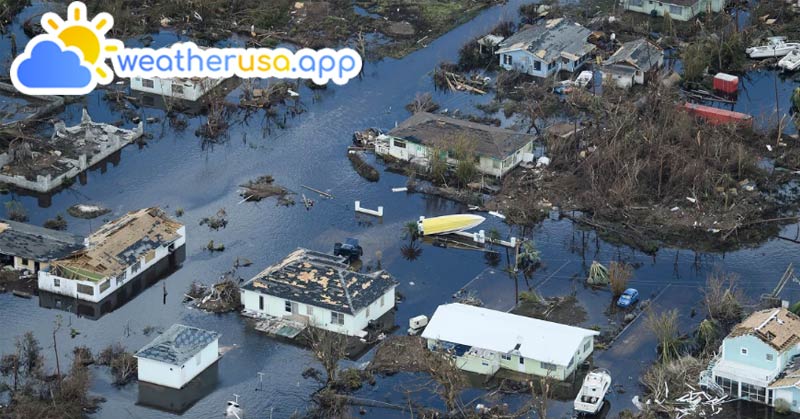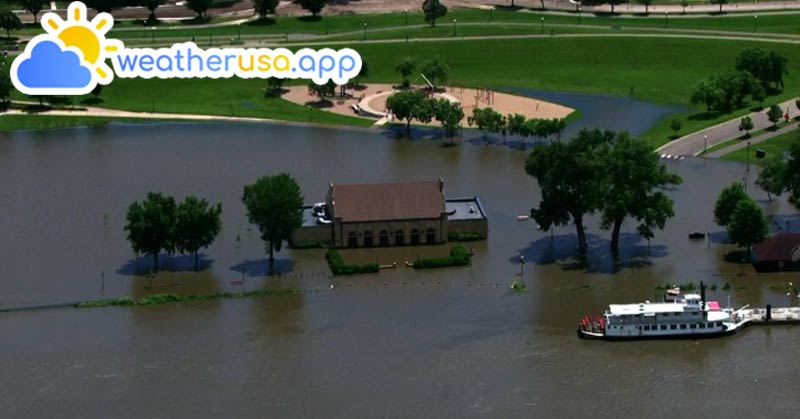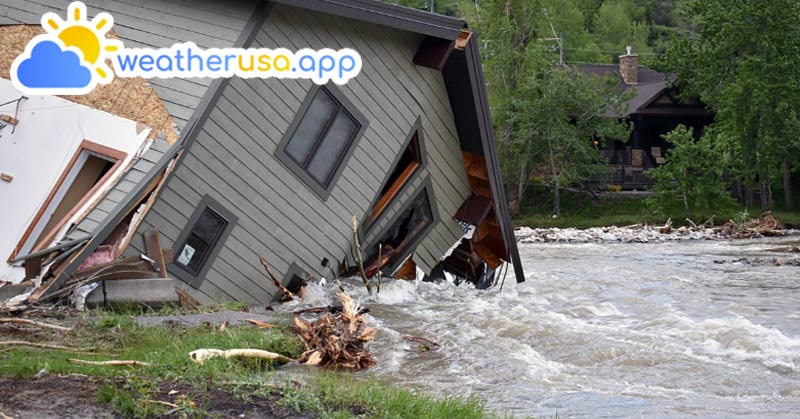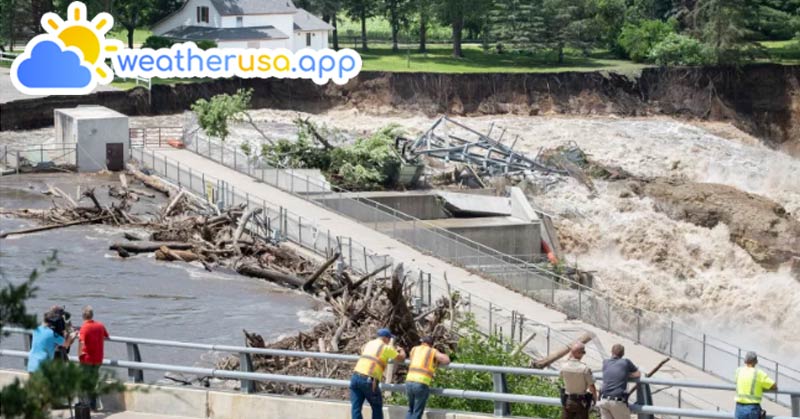
Rivers in Northwest Iowa are flooding homes and farms, and the water is now moving downstream
Gov. Kim Reynolds has expanded her state disaster proclamation for flooding in western Iowa to include five additional counties along the Missouri River, where water levels continue to rise. Fremont, Mills, Pottawattamie, Harrison, and Monona have been added, bringing the total number of affected counties to 27. While the Army Corps of Engineers does not anticipate major flooding along the Missouri, levee systems along the river are being closely monitored.
See more: Weather Iowa for the next 3 days
In Rock Valley, volunteers began cleanup efforts on Monday after an estimated 500 homes were flooded in the Sioux County community. Steve Gacke, who has experienced flooding before but lacks flood insurance, is considering leaving Rock Valley. “I don’t know what the city’s going to do,” Gacke said. “I don’t think people are going to want to live here anymore because it happens so often. It’s been 10 years since the last flood. Something’s got to change. We don’t want to stay here.”
The Rock River in Rock Valley crested nearly five feet higher than during the 2014 flood.
No deaths have been reported from the widespread flooding in Iowa, but one person is confirmed missing in Rock Valley. Radio Iowa also reports that the driver of a submerged vehicle in Spencer has not been found.
Evacuations in Sioux City
Emergency officials in Woodbury County have begun evacuating residents from the Riverside area on the north side of Sioux City. Other residents along the Big Sioux River have been advised to prepare to evacuate if water levels continue to rise. For now, officials are going door-to-door to evacuate people as needed. Although river water levels have “stabilized,” they have not yet begun to fall.
The Tyson Events Center in Sioux City is open as a shelter for those who need to evacuate or choose to leave their homes.
See more: Weather forecast zipcode in 50001 - Ackworth IA
Governor Reynolds Visits Flooded Areas
Gov. Kim Reynolds is scheduled to visit northwest Iowa on Monday to meet with local officials about the flood response in Hawarden, Rock Valley, Rock Rapids, Spencer, and Cherokee.
The Red Cross has opened a shelter at a high school in Correctionville for those displaced by the Little Sioux River, which is nearing a record flood level.
Climate and Average Weather in 50002 - Adair IA
Rock Valley is seeking volunteers for cleanup starting Monday morning. Volunteers should enter the town from the south and check in at the Cooperative Farmers Elevator.
Some flooded communities have reported they no longer need physical donations or will request specific items as needed. Iowa Director of Homeland Security John Benson advised that physical donations can burden already overwhelmed communities. Instead, cash donations are preferred as they allow local officials to cover immediate and long-term costs. Iowa Homeland Security plans to post online updates about needed items and verified flood recovery funds.
See more: Weather forecast for Iowa
Record-Breaking Floods
Heavy rains over the weekend set new records in northwest Iowa, with storms dropping between 10 and 15 inches of rain across parts of Nebraska, South Dakota, Minnesota, and Iowa. Rivers, including the Little Sioux, Big Sioux, and Rock, have flooded homes and farms, and high water is expected to impact downstream communities in the coming days.
Weather Forecast For 50003 - Adel IA
Gov. Reynolds noted that the recent surge drove rivers to levels surpassing the 1993 flood, which had long been a high water mark for the state. “In almost every community impacted, the rivers crested several feet above the record levels from the floods of 1993,” Reynolds said during a press conference at the State Emergency Operations Center in Johnston. “In fact, we had 16 flood gauges that recorded historic levels.”
According to Reynolds, 250 people were rescued in northwest Iowa on Saturday. Over 1,000 flood victims sought refuge in community shelters that night, and early estimates indicate at least 1,900 properties were flooded, including significant areas of farmland.
In Spencer, floodwaters divided one side of the town from the other, and in Rock Valley, the Rock River surpassed its previous record flood level by nearly five feet.

One of the communities hardest hit by the weekend’s flooding was Rock Rapids, a town of about 4,000 in Sioux County. The area, which experienced significant flooding in 2014 and 2018, saw its new berm fail to withstand the Rock River's surge early on Saturday.
Approximately 500 homes were flooded, including that of Jeri Boeve, who was rescued by boat on Saturday morning.
“I wasn’t surprised the berm broke with that much rain,” Boeve said. “It was just too much pressure—millions of tons from the water. There was nothing the city could have done.”
Boeve returned to her property on Sunday to begin cleanup.
“Right now, everyone in our neighborhood is pumping out their basements. We had about 5 feet of water in ours.”
Jaselyn Wissink and other volunteers worked to clean sewage out of Ransom Church in Rock Rapids on Sunday afternoon. Her own home also suffered from a sewer surge after the first round of flooding on Thursday, with more severe flooding following on Saturday.
“People should really keep northwest Iowa in their thoughts and prayers,” Wissink said. “It’s incredibly tough.”
Weather Iowa for the next 7 days - Iowa
Wissink noted that many businesses in town are damaged or destroyed, with water levels surpassing those from the record-breaking flood a decade ago, which had already forced the demolition of dozens of homes.
Floods Moving Downriver
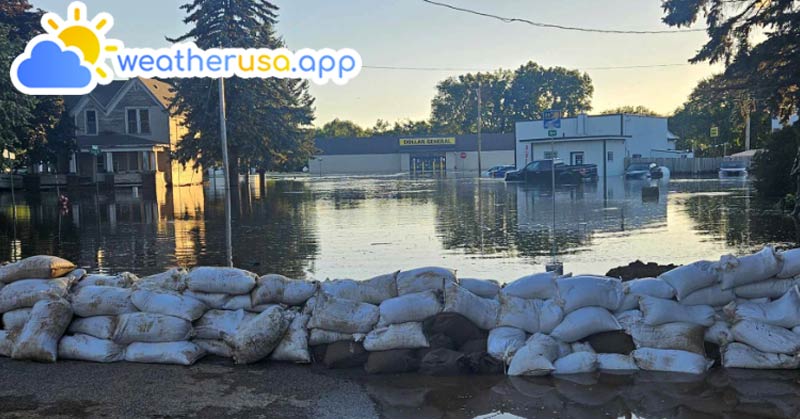
Emergency officials are warning that the historic flooding that struck northwest Iowa over the weekend will continue to move downstream over the next several days.
While water levels are decreasing on some rivers, the Little Sioux River is not expected to crest until Tuesday evening. Forecasts predict a new record high for the West Fork of the Des Moines River at Humboldt sometime mid-week.
With additional rain likely, Iowa Director of Homeland Security and Emergency Management John Benson is coordinating with emergency officials across western and eastern Iowa to prepare for further high water.
Benson emphasized that the flooding is far from over. “This flood is not finished,” Benson said. “All the water you see in northwest Iowa is flowing into the Missouri River. River gauges on the Missouri are rising quickly and will continue to do so.”
On the Missouri River in western Iowa, the Army Corps of Engineers has deployed levee surveillance teams. The river is expected to crest at minor to moderate levels of flooding. According to an Army Corps official, no major impacts are anticipated as long as the levees along the river remain intact.
Reynolds Seeks Additional Disaster Declaration
Gov. Reynolds is requesting federal assistance following the historic flooding. On Sunday, she announced that she is seeking a major disaster declaration from the White House to provide individual and small business aid in nine counties: Buena Vista, Clay, Dickinson, Emmet, Lyon, O’Brien, Osceola, Plymouth, and Sioux.
See more: Zipcode in 50005 - Albion IAa
Additionally, she is requesting assistance for rebuilding public infrastructure across a 22-county area. Flooding has forced at least ten community water systems to shut down, and Reynolds noted that officials are still unable to assess the full extent of the damage to roads, bridges, and highways.
If granted, this would be Iowa’s third federal disaster declaration since April, following a series of severe tornadoes.
Kelly Garcia, Iowa’s Director of Health and Human Services, stated that the state will also apply for disaster food assistance if the presidential disaster declaration is approved.
Disaster SNAP (D-SNAP) eligibility considers financial and property losses and allows families to purchase prepared food, a benefit not available under the normal SNAP program. This provision is intended to assist families displaced from their homes who are temporarily staying in hotels or shelters.
Weather 01852 - Lowell MA

69°
overcast clouds
Feels like 68°06:17/19:09
70°F
/66°F
74%
1009 hPa
7 mi
8.05 mph
